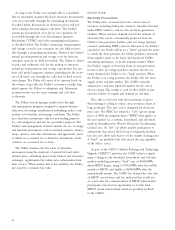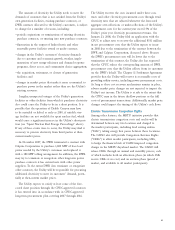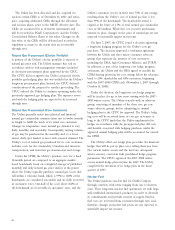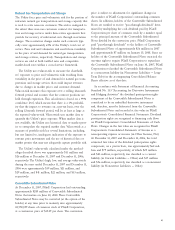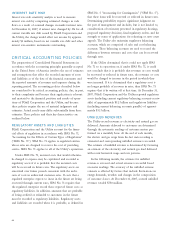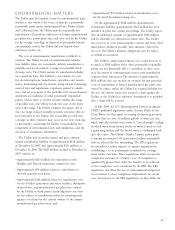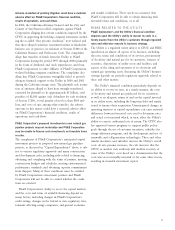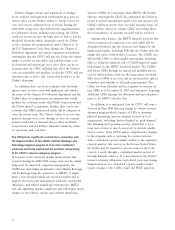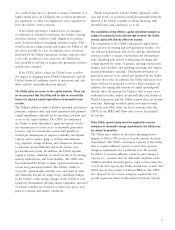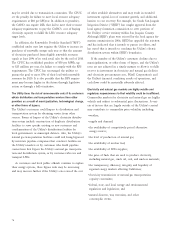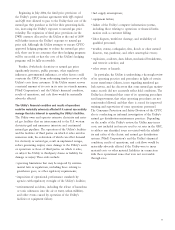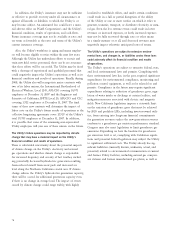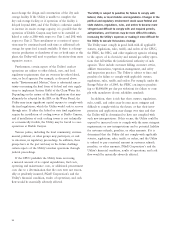PG&E 2007 Annual Report Download - page 72
Download and view the complete annual report
Please find page 72 of the 2007 PG&E annual report below. You can navigate through the pages in the report by either clicking on the pages listed below, or by using the keyword search tool below to find specific information within the annual report.70
California State Water Resources Control Board (“Water
Board”) published a draft policy for California’s imple-
mentation of Section 316(b) that proposes to eliminate the
EPA’s site-specifi c compliance options, although the draft
state policy would permit environmental restoration as a
compliance option for nuclear facilities if the installation of
cooling towers would confl ict with a nuclear safety require-
ment. Various parties separately challenged the EPA’s regula-
tions in court, and the cases were consolidated in the U.S.
Court of Appeals for the Second Circuit (“Second Circuit”).
In January 2007, the Second Circuit remanded signifi cant
provisions of the regulations to the EPA for reconsidera-
tion and held that a cost-benefi t test could not be used to
comply with performance standards or to obtain a variance
from the standards. The Second Circuit also ruled that envi-
ronmental restoration cannot be used to comply with the
standard. Petitions requesting U.S. Supreme Court review of
the Second Circuit decision are pending, and the EPA has
suspended its regulations. It is uncertain when the EPA will
issue revised regulations, whether the Supreme Court will
accept review of the Second Circuit decision, how judicial
developments will affect the EPA’s revised regulations, how
judicial developments and the EPA’s revised regulations
will affect the Water Board’s proposed policy, and when
the Water Board will issue its fi nal policy. Depending on
the nature of the fi nal regulations that may ultimately be
adopted by the EPA or the Water Board, the Utility may
incur signifi cant capital expense to comply with the fi nal
regulations, which the Utility would seek to recover through
rates. If either the fi nal regulations adopted by the EPA or
the Water Board require the installation of cooling towers
at Diablo Canyon, and if installation of such cooling
towers is not technically or economically feasible, the Utility
may be forced to cease operations at Diablo Canyon.
LEGAL MATTERS
PG&E Corporation and the Utility are subject to various
laws and regulations and, in the normal course of business,
PG&E Corporation and the Utility are named as parties in
a number of claims and lawsuits.
In accordance with SFAS No. 5, PG&E Corporation and
the Utility make a provision for a liability when it is both
probable that a liability has been incurred and the amount
of the loss can be reasonably estimated. These provisions
are reviewed quarterly and adjusted to refl ect the impacts of
negotiations, settlements and payments, rulings, advice of
legal counsel, and other information and events pertaining
to a particular matter. In assessing such contingencies, PG&E
Corporation’s and the Utility’s policy is to exclude antici-
pated legal costs.
The accrued liability for legal matters is included in PG&E
Corporation’s and the Utility’s Current Liabilities — Other in
the Consolidated Balance Sheets, and totaled approximately
$78 million at December 31, 2007 and approximately $74 mil-
lion at December 31, 2006.
After considering the above accruals, PG&E Corporation
and the Utility do not expect that losses associated with legal
matters will have a material impact on their fi nancial condi-
tion or results of operations.
RISK FACTORS
RISKS RELATED TO PG&E CORPORATION
PG&E Corporation could be required to contribute capital to
the Utility or be denied distributions from the Utility to the
extent required by the CPUC’s determination of the Utility’s
fi nancial condition.
In approving the original formation of a holding company
for the Utility, the CPUC imposed certain conditions,
including an obligation by PG&E Corporation’s Board of
Directors to give “fi rst priority” to the capital requirements
of the Utility, as determined to be necessary and prudent
to meet the Utility’s obligation to serve or to operate the
Utility in a prudent and effi cient manner. The CPUC later
issued decisions adopting an expansive interpretation of
PG&E Corporation’s obligations under this condition,
including the requirement that PG&E Corporation “infuse
the Utility with all types of capital necessary for the Utility
to fulfi ll its obligation to serve.” The CPUC’s interpretation
of these obligations could require PG&E Corporation to
infuse the Utility with signifi cant capital in the future, or
could prevent distributions from the Utility, either of which
could materially restrict PG&E Corporation’s ability to meet
other obligations or execute its business strategy.


